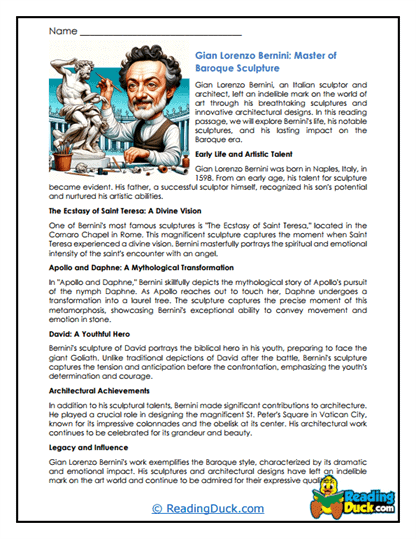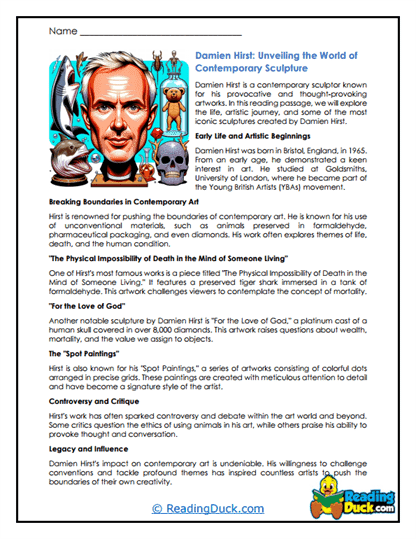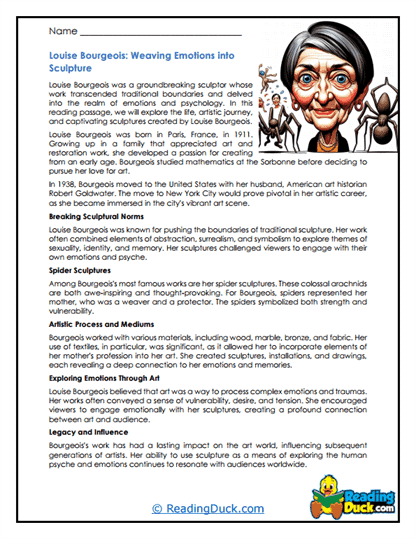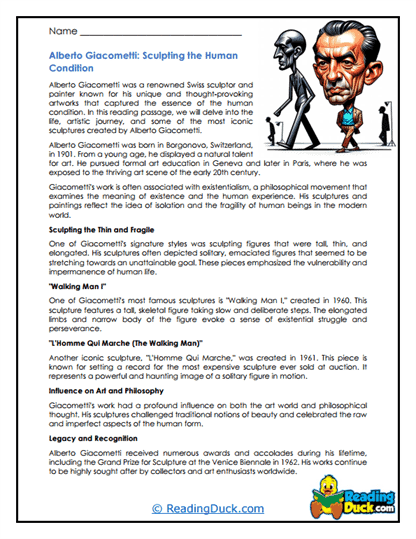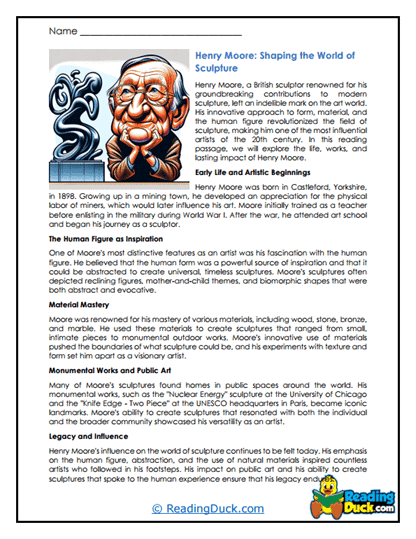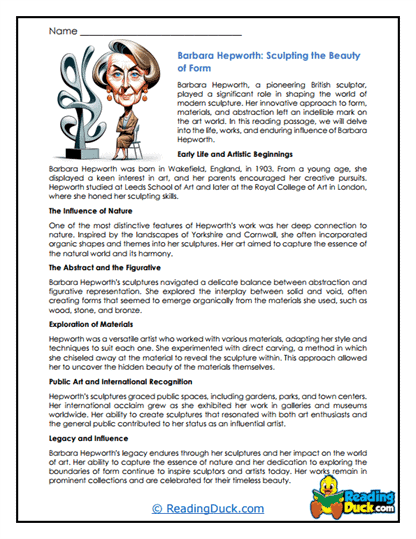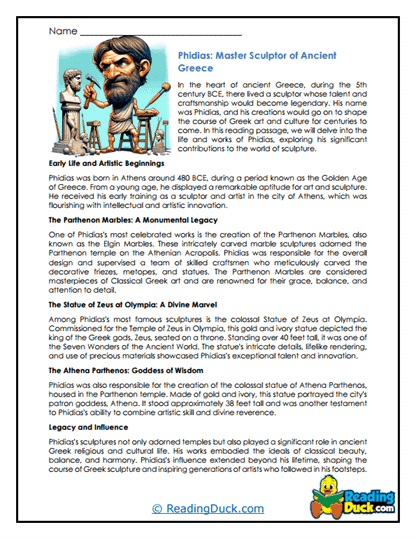Sculptors Worksheets
About Our Sculptors Worksheets
Our Sculptors Worksheets provide a comprehensive and engaging exploration of the art of sculpture, covering key figures, techniques, and historical contexts that have shaped this three-dimensional art form. These worksheets are designed to introduce students to the world of sculpture, from ancient works to modern creations, and to help them understand the significance of sculptors and their contributions to the history of art.
Each worksheet set includes:
- Multiple Choice Questions: These questions assess students' comprehension of the reading passages, focusing on essential details about the sculptors, their techniques, and the impact of their works.
- Short Answer Questions: Students are prompted to provide concise responses, summarizing critical information, analyzing sculptural methods, and reflecting on the significance of different styles and movements in sculpture.
- Open-Ended Questions: These questions encourage students to think critically and express their personal interpretations, opinions, and preferences regarding the sculptures discussed, allowing for a deeper connection to the material.
These worksheets are designed to help students demonstrate their understanding of sculpture and foster a meaningful engagement with the art form. An answer key is provided for each question sheet, making it easy for teachers and parents to evaluate student progress. The worksheets are available in PDF format, ensuring they can be easily viewed electronically, downloaded, and printed.
Shaping Ideas in Three Dimensions: Exploring the Art of Sculpture
Sculpture is one of the oldest and most enduring forms of art, with a history that stretches back to the earliest civilizations. Unlike painting or drawing, sculpture involves the creation of three-dimensional forms, making it a unique and powerful medium for expressing ideas, emotions, and stories. Sculptors have used a wide range of materials and techniques to bring their visions to life, from the stone statues of ancient Greece to the abstract forms of contemporary artists.
Students exploring the art of sculpture will delve into several key aspects:
- Fundamental Techniques of Sculpture: Sculpture involves a variety of techniques that artists use to shape materials into three-dimensional forms. Students will learn about basic methods such as carving, modeling, casting, and assembling. These techniques help sculptors manipulate materials like stone, clay, metal, and wood to create works that can range from realistic representations to abstract shapes. Understanding these techniques provides students with a deeper appreciation for the skill and creativity involved in sculpture.
- Tools and Materials: The tools and materials used in sculpture are crucial to the final outcome of the artwork. Students will explore the different types of materials that sculptors use, such as marble, bronze, plaster, and found objects, and how these choices affect the texture, durability, and appearance of the sculpture. This knowledge helps students understand the practical aspects of sculpture and how different materials can be used to achieve specific artistic goals.
- Exploring Various Styles and Movements: Sculpture has evolved through numerous styles and movements, each with its own distinct characteristics and philosophies. Students will study a range of styles, from the realism of classical sculpture to the abstraction of modern art. They will also explore movements such as the Renaissance, Baroque, Neoclassicism, and Surrealism, learning how each style reflects the cultural and historical context in which it emerged. This exploration helps students appreciate the diversity of sculpture and how artists use different approaches to convey their ideas and emotions.
- The Role of Space and Form: In sculpture, space and form are central to the effectiveness of the artwork. Students will investigate how sculptors use space to create a sense of depth, movement, and balance in their work. They will also study how the form of the sculpture interacts with the surrounding environment, whether it is placed in a gallery, a public space, or a natural setting. This aspect of sculpture helps students develop an understanding of how three-dimensional art can engage viewers from multiple perspectives.
- Historical and Cultural Significance: Sculpture has often been a reflection of the cultural, social, and political contexts of its time. Students will explore how sculptures from different periods convey the values, beliefs, and concerns of the societies that produced them. For example, they might study how the sculptures of ancient Egypt were used to convey power and divinity, or how modern sculptures challenge traditional notions of form and space. Understanding the historical and cultural significance of sculptures helps students see art as a window into the past and a commentary on the present.
- Iconic Sculptors and Their Masterpieces: Throughout history, certain sculptors have left a lasting impact on the world of art, creating works that are celebrated for their innovation, beauty, and influence. Students will study the lives and works of iconic sculptors such as Michelangelo, whose David and Pietà are considered masterpieces of Renaissance art; Auguste Rodin, known for his expressive and powerful forms such as The Thinker; and Barbara Hepworth, a pioneer of modern abstract sculpture. By examining these artists' masterpieces, students will gain insight into the creative processes, challenges, and triumphs that have shaped the course of art history. This exploration of iconic sculptors helps students understand the importance of individual expression and the ways in which sculpture can change the world.
- Modern and Contemporary Sculpture: While much of art history focuses on the past, it is also important for students to explore the innovations and trends of modern and contemporary sculpture. Students will examine how contemporary sculptors continue to push the boundaries of sculpture, experimenting with new materials, techniques, and concepts. This exploration of modern and contemporary sculpture helps students see how the art form continues to evolve and respond to the challenges and opportunities of the present day.
Through the study of sculpture, students will develop a deeper understanding of how this art form has been used throughout history to express the human experience, challenge conventions, and inspire change.
How Teachers and Parents Can Integrate These Worksheets in a Learning Curriculum
Integrating the study of sculpture into a learning curriculum can provide students with valuable skills and insights that extend beyond the art classroom. Here are some practical ideas for using these worksheets in the classroom or at home:
- Incorporate Sculpture Practice Sessions: Use the worksheets as a starting point for hands-on sculpture practice sessions where students apply the techniques they’ve learned. This could include exercises in modeling clay, carving soap or foam, or assembling found objects, allowing students to refine their skills in a focused setting.
- Connect Sculpture with Other Subjects: Integrate sculpture with other subjects such as history (exploring the historical context of famous sculptures), literature (creating sculptures inspired by characters or scenes from a novel), or science (creating models of scientific concepts). This interdisciplinary approach helps students see the relevance of sculpture across different fields of study.
- Group Critiques and Discussions: After completing the worksheets, hold group discussions where students share their interpretations of the sculptures studied. This can foster a sense of community and collaboration while also providing constructive feedback that helps students improve their analytical skills.
- Explore Cultural Art Traditions: Encourage students to research and create sculptures inspired by different cultural art traditions, such as African, Asian, or Indigenous art. This broadens their understanding of global art practices and fosters an appreciation for the diversity of artistic expression.
- Field Trips or Art Walks: Organize field trips to local art museums, galleries, or public art spaces where students can observe and discuss sculptures in person. Alternatively, conduct an art walk around the school or community where students can practice sketching or creating sculptures from natural materials.
- Supplement with Art History Lessons: Use the worksheets as a springboard for lessons on the history of sculpture and the study of famous sculptors. This can include watching documentaries, reading biographies, or exploring online art collections, providing students with a broader context for their practice.
- Use Technology to Enhance Learning: Incorporate digital tools by having students use 3D modeling software or apps to experiment with different styles and techniques. This can be especially useful for exploring contemporary sculpture practices and understanding the role of technology in modern art.
- Adapt for Various Skill Levels: Tailor the complexity of the worksheets to suit different grade levels. Younger students might focus on basic sculptural techniques and simple forms, while older students can tackle more complex styles and detailed studies of famous sculptures.
Studying sculpture through these worksheets can significantly enhance students' creativity, spatial awareness, and appreciation for the visual arts. By engaging with the techniques, styles, and cultural contexts of sculpture, students develop a greater understanding of how art can communicate ideas, emotions, and narratives in three dimensions. These skills not only contribute to success in the classroom but also foster a lifelong interest in art and creative expression, encouraging students to explore and appreciate the world around them.
